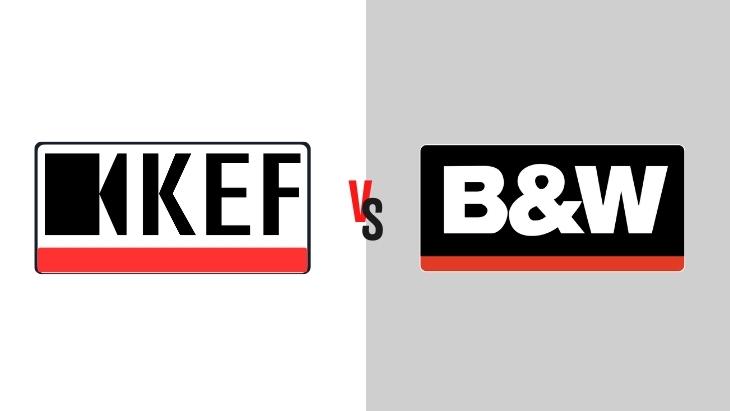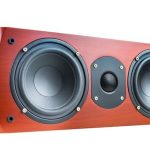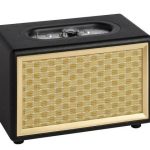Welcome to the ultimate battle of audio titans: KEF vs B&W. Both have established themselves as two premier brands within the world of high-fidelity sound, offering audiophiles around the globe exceptional craftsmanship and sonic excellence. But which brand should you choose?
In this comprehensive comparison, we dive deep into each brand’s offerings to uncover their unique strengths – helping music lovers and home theater fans alike find out which one reigns supreme. We’ll guide you through it all with an unbiased eye on what matters most: your needs for quality sound. So strap in and let’s get ready for a thrilling showdown between these two powerhouses!
KEF vs B&W – Sound Quality Comparison
For over half a century, KEF has been crafting speakers that bring music to life with exceptional clarity and detail. Their pioneering engineering means the Uni-Q driver arrangement delivers an expansive soundstage. Besides, the precise imaging and balanced frequency response are perfect for your next movie night or when you’re bumping those chart-topping bangers!
Whether you’re an audiophile or just want to add some extra oomph to your playlists, KEF ensures unmatched audio quality that’ll have even the faintest sounds coming through loud and clear. Upgrade your listening experience today: get ready for mind-blowing sounds from KEF!
B&W, or Bowers & Wilkins, has built its success upon providing listeners with uncompromising audio quality – no corners are cut when it comes to delivering an immersive listening experience that rivals what you’d hear at a live show.
B&W speakers are celebrated for their signature warm and rich sound signature, often regarded as a gold standard in the audiophile community. The brand’s meticulous attention to detail in driver design, cabinet construction, and crossover technology results in a sonic experience that is immersive, dynamic, and emotionally captivating. While KEF emphasizes accuracy and precise sound reproduction, B&W tends to offer a more euphonic and engaging sound character.
When comparing sound quality between KEF and B&W, it is essential to consider factors such as frequency response, imaging, soundstage, tonal balance, and overall musicality. Audiophiles who crave a detailed and analytical sound may lean towards KEF, appreciating its transparent sound reproduction. On the other hand, those seeking a richer and more captivating sonic experience might find solace in B&W’s warm and engaging sound signature.

Examining the Differences in Speaker Design
KEF takes pride in its innovative Uni-Q driver design, which sets it apart from traditional speaker configurations. The Uni-Q driver combines a tweeter and mid-range driver into a single point source, resulting in coherent and precise sound dispersion. This concentric driver arrangement minimizes phase issues and provides a wider sweet spot, allowing listeners to enjoy a more accurate and immersive soundstage. KEF’s Uni-Q technology is often praised for its ability to create a cohesive and seamless sound image, where instruments and vocals are precisely positioned in the sonic landscape.
On the other hand, B&W incorporates its own advanced driver technologies to achieve outstanding sound reproduction. B&W speakers often feature separate tweeters and mid-range drivers positioned strategically within the cabinet. The brand’s dedicated attention to driver materials, such as diamond, Kevlar, and aluminum, enhances rigidity and reduces distortion, resulting in clean and detailed sound reproduction across the frequency spectrum. B&W’s approach to speaker design aims to achieve a balance between accuracy, musicality, and dynamic range.
Cabinet construction plays a crucial role in speaker design, affecting both sound quality and overall aesthetics. KEF employs various cabinet materials and techniques to reduce unwanted resonances and vibrations. Their use of constrained layer damping, curved cabinets, and bracing techniques minimizes cabinet-induced coloration, allowing the drivers to perform optimally and deliver cleaner sound reproduction.
Similarly, B&W focuses on cabinet rigidity and resonance control. The brand utilizes techniques like matrix bracing, internal damping materials, and carefully engineered cabinet shapes to ensure that the speakers’ sonic performance remains uncompromised. B&W’s dedication to cabinet design ensures that the speakers effectively reproduce audio without the distortion caused by cabinet resonances.
With both KEF and B&W, expect speakers that are not just good-looking but also masterfully crafted. With KEF, you get modern minimalism in all its glory – clean lines and an uncluttered aesthetic. Meanwhile, B&W injects a bit of timeless elegance into the mix with luxurious finishes and intricate attention to detail. Whether you’re looking for high style or sleek sophistication, these two brands have got your audio needs covered.
KEF versus B&W Amplification Requirements
KEF speakers are renowned for their impressive sensitivity levels, making them incredibly adept at transforming power into sound. This makes them a great option for any amplifier setup – whether you’re working with high-powered or lower-powered systems. With these versatile speakers, cranking up the volume has never been easier! KEF provides specifications such as impedance and recommended amplifier power range for each of their speaker models, giving users a clear understanding of the required amplification.
B&W speakers have long been celebrated for their impressive sound reproduction. The variety of sensitivities and impedance levels across their product range means they are compatible with a broad selection of amplifiers–from budget models to high-end ones. Whether you’re an audiophile looking for top-tier performance or just entering into the world of home audio systems, B&W has something to offer everyone. B&W provides recommendations regarding amplifier power and impedance for each speaker model to help users make informed decisions.
Considering the impedance rating is essential as it affects how much power the amplifier can deliver to the speakers. Matching the amplifier’s impedance capabilities to the speakers’ impedance will ensure efficient power transfer and optimal performance.
Room Acoustics Considerations
KEF offers valuable insights into room acoustics considerations through its Music Integrity Engine. This technology applies advanced digital signal processing to account for room anomalies, such as reflections and resonances, and corrects them to optimize sound performance. KEF provides guidelines on speaker placement, suggesting ideal distances from walls and corners to minimize unwanted reflections and maximize the speaker’s performance within the room.
Similarly, B&W emphasizes the impact of room acoustics on sound quality. Their Formation app includes room EQ functionality, allowing users to adjust the speaker’s response to compensate for room characteristics. B&W also provides general guidelines on speaker placement and encourages experimentation to find the optimal positioning that minimizes detrimental room interactions.

Home Theater Performance
Are you a home theater enthusiast looking for the perfect speakers? Look no further than KEF. Their products are designed to deliver crystal clear sound, letting every dialogue and song be heard with incredible detail. The Uni-Q driver technology creates an expansive soundstage that immerses viewers in whatever they’re watching – it’s like being transported right into the movie!
Moreover, their dedicated center channel speakers make sure conversations come across loud and clear. That way, your favorite characters can truly come alive. With KEF speaker systems, your home theater experience will never be the same!
B&W, with its commitment to uncompromising audio quality, also excels in home theater applications. B&W produces speakers that deliver truly cinematic soundtracks. Their dynamic range packs a punch while providing accurate imaging and tonal accuracy to pick up even the subtlest of details from movies. With these features combined, you can experience vivid audio that feels lifelike and engaging – like being inside your own movie theater! The brand’s dedicated center channel speakers, surround speakers, and subwoofers work in harmony to create a cohesive and enveloping soundstage.
Furthermore, both KEF and B&W offer compatibility with popular surround sound formats, such as Dolby Atmos and DTS: X. These formats enable a three-dimensional audio experience by incorporating overhead speakers or utilizing speaker modules that bounce sound off the ceiling. That way, they add a new dimension of height and immersion to the home theater setup.
KEF vs B&W Build Quality and Durability
KEF’s speakers are crafted with attention to detail and durability in mind. They employ high-quality materials in their driver construction, cabinet construction, and internal components. KEF’s use of techniques like constrained layer damping and bracing helps to minimize unwanted vibrations and resonances. This ensures that the speakers perform optimally and remain structurally sound over time.
Similarly, B&W places a strong emphasis on build quality and durability. Their speakers are meticulously engineered and constructed using premium materials, including rigid cabinets and specialized driver materials. B&W’s dedication to cabinet design and internal bracing enhances the speakers’ overall structural integrity, reducing unwanted vibrations and ensuring long-term durability.
Price Range
KEF and B&W have a range of speakers to fit any budget, from those just starting out to audiophiles who want the best of the best. KEF has offerings for everyone – entry-level options that won’t break the bank start at around a couple of hundred dollars while their top-tier models can be upwards of four figures.
On the other hand, B&W is known for producing premium sound systems and their pricing reflects this; even their most basic models begin at several hundred dollars with more advanced options going well over five thousand bucks! If you’re looking for truly high-end audio quality like something straight out of The Great Gatsby or an episode of Euphoria, it’s worth considering one (or both!) of these amazing brands.
Value Proposition
Both KEF and B&W have a strong reputation for engineering excellence and sound quality, but they approach it in slightly different ways. Here’s a general overview of their value propositions:
KEF focuses on innovative design and advanced technologies to deliver exceptional sound reproduction. They are known for their Uni-Q driver technology, which combines a tweeter and midrange driver concentrically. This design from KEF offers an incredibly precise and accurate soundstage, immersing listeners in a wide and stunningly vivid sonic landscape.
Masterfully crafted with meticulous attention to detail, these speakers provide clear audio reproduction that is balanced, natural-sounding, and satisfying for even the most discerning of audiophiles. B&W’s signature style brings a luxurious aesthetic – delivering clarity, tonal accuracy, and intensity for any listening experience.
Final Thoughts on KEF vs B&W
Both KEF and B&W are highly respected and esteemed brands in the audio industry, known for their commitment to quality and exceptional sound reproduction. While they have their unique approaches and characteristics, both offer excellent options for audio enthusiasts and professionals. Thus, when choosing between KEF and B&W speakers, it all comes down to personal preference.
To make the best decision for your listening setup, budget, and favorite music genre, you should take time out to compare both brands. Additionally, seek professional advice when possible; read reviews of specific models from each brand as well as consider factors such as room size – all before making your final choice!
Michael Evanchuk is a San Francisco-based sound engineer with 20 years’ experience installing, troubleshooting, and repairing commercial, automotive, and household sound equipment. Evanchuk owns an auto stereo center, where he offers highly competitive car audio installation and repair services. He has written dozens of articles on different sound engineering topics, all of which have been published in leading journals, blogs, and websites.





